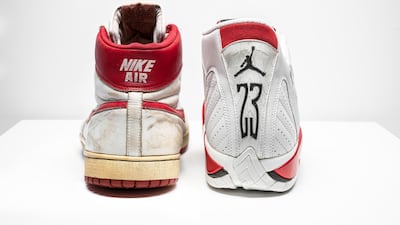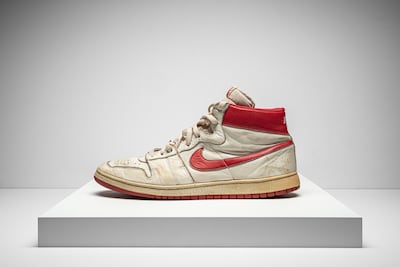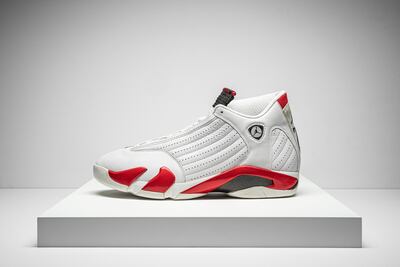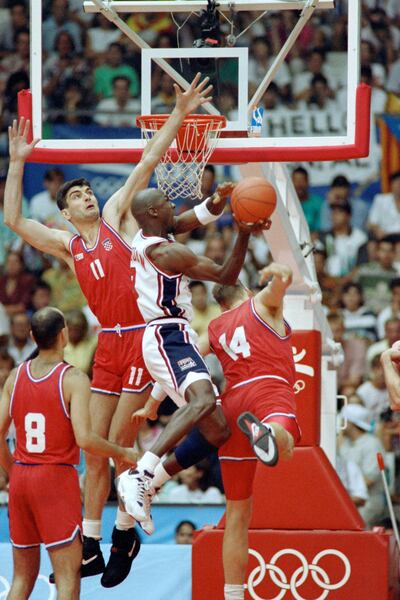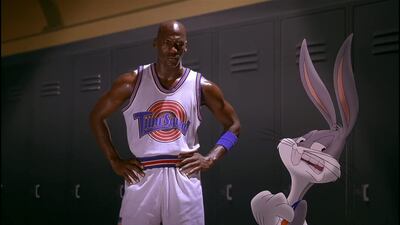“This is history. And it’s 100 per cent art, right up there with Picasso,” says Gerard Starkey.
He’s not talking about a painting or a sculpture; instead, he’s referring to a scuffed, 35-year-old pair of trainers with a piece of glass embedded in one of the soles.
The 'shattered backboard' shoes
Starkey is a leading Michael Jordan memorabilia collector, and the shoes he’s referring to were worn by the basketball superstar during a particularly memorable incident early on in his career. It was August 25, 1985, and Jordan was in Trieste, Italy, playing in a Nike-sponsored exhibition game. Sporting a pair of Air Jordan 1 High trainers, Jordan went in for a dunk, soaring through the air in his trademark style before slamming the ball into the hoop. Moments later, the backboard shattered, raining shards of glass down over the court.
The incident was a striking symbol of Jordan’s power as a player, but also stands as a metaphor for how he would go on to shatter records, expectations and stereotypes over the course of his career. The shoes he was wearing at the time, dubbed the Air Jordan High “Shattered Backboard” Origin Story Sneakers, were one of 11 pairs of game-worn and player-exclusive Jordan shoes that featured in the first trainer auction by Christie’s last month.
Run in partnership with Stadium Goods, Original Air was a landmark sale that solidified streetwear’s standing at the very upper echelons of the luxury industry. But that’s not news to Ben Jacobs, brand director of Stadium Goods, a trainers and streetwear marketplace at the forefront of this rapidly expanding resale segment.
Jordan the super hero
“Sneaker-collecting enthusiasm and sneakerheads have been around for a long time, but in the last plus or minus five years, you’ve had men on a larger scale accessorising and embracing sneakers as a style statement piece. And for women, it’s finally become more socially acceptable to just wear what is comfortable. I think that’s really helped contribute to the rise in interest in sneakers,” says Jacobs.
Trainers that actually belonged to and were worn by Jordan are the holy grail in this space. “You have people like myself, in their mid to late-thirties, who grew up with Michael Jordan, this god-like figure who wore various capes, or pairs of shoes, for his endless heroic athletic performances,” says Jacobs. “He embodied everything that was cool; he had this swagger and you wanted every version of every item that he wore with such grace and confidence.
“What we are doing with Christie’s is an extension of the passion and love and history and community that Stadium Goods has come from, and we are presenting true artefacts that have helped to shape and mould that culture that we are a part of.”
Trainers as artefacts
It is not an overstatement to call them artefacts. The shoes that featured in the Christie's sale chart the history of basketball, the evolution of trainer design, the legend of Michael Jordan, and his influence on popular culture. And, as highlighted by the popularity of the 10-part docu-series The Last Dance, there is still plenty of residual interest in that legacy.
Russ Bengtson, former editor-in-chief of Slam magazine, and a keen Micheal Jordan historian and collector, makes no differentiation between collecting trainers of this calibre and collecting in more established luxury categories, such as watches.
“Some of the watches that I’m into are chronographs that were introduced in the 1960s, and those were developed as tools, whether it’s a TAG Heuer Carrera, or even a Rolex Daytona. They served a purpose. And basketball shoes, particularly ones designed for Michael Jordan, or in some cases by Michael Jordan, those were tools also, designed to help him do what he did, at the highest level.”
Air Ship to Air Jordan 14
Original Air served up a whistle-stop tour of Jordan's career – from the 1984 Air Ship worn in the earliest days of his rookie season, which were customised for the basktball star, with a lower cut and a more condensed sole that acted as a predecessor to the famed Air Jordan 1 ("This is them experimenting in real time on what would became the Air Jordan 1. This is Jordan wear-testing his own signature shoe," says Bengtson); to the Air Jordan 10 Sample Baseball Cleat, produced for Jordan when he temporarily retired from the Chicago Bulls in 1995 to try his hand at baseball; to the Air Jordan 14 "Chicago", worn during practice over the course of Jordan's final season, as seen in The Last Dance.
Jordan’s continued appeal was reflected in the success of the online auction, which achieved total sales of $931,875 (Dh3.4 million) and attracted 90,000 unique visitors from 126 countries. Notably, 72 per cent of registered bidders were new to Christie’s.
Unsurprisingly, the “Shattered Backboard” trainers emerged as the top lot, selling for $615,000. One of the most remarkable things about this pair of shoes was the amount of evidence on hand to enable Starkey, who acted as an expert adviser for the Original Air sale, to verify them.
First, there is the distinct lacing. “Michael Jordan always laced his shoes up a certain way,” Starkey explains. “There are plenty of photos of him going through his process – preparing himself for battle, so to speak. When attributing a shoe to an athlete, you have to consider every single facet. The lacing of this shoe is quite tight and consistent with the photos.”
Then there is the wear and creasing, which can be precisely matched to photos of Jordan taken on that eventful day in 1985, a rarity themselves. “Taking photos of Michael Jordan in his rookie year was not that big a thing,” Starkey points out.
“But we can match these shoes to photos in 1985, when people weren’t even really concerned about sneakers. Players were not walking through the tunnels, holding up the sneakers they were going to wear, with photos being taken left, right and centre. The moment LeBron [James] or any of those players steps on court, the first thing people do is take a photo of their sneakers. That just wasn’t the case back then.”
Then there are the signatures, where Jordan’s name is spelt out in full – something he more or less stopped doing after his rookie season. And finally, there is that shard of glass, still embedded in the sole of the left shoe more than three decades later.
“I’ve collected for 23 years and I have personally never seen anything of this level in my entire career,” says Starkey. “This is the ultimate bit of nostalgia – and it has resonated through time.”
But the best anecdote from the sale comes, arguably, with the Air Jordan 7 “Olympic” trainers worn by Jordan when he achieved gold at the 1992 Olympics in Barcelona, as part of what is widely recognised as the greatest basketball team in living history.
A dream gift from the Dream Team
“The ‘Dream Team’ stayed at the Ambassador hotel just off the Ramblas and the receptionist was a young Spanish man. His younger brother, who was 12 or 13 at the time, was allowed to hang around the hotel, and we’ve got their security IDs and payslips to prove they were there,” Starkey explains.
"Michael Jordan refers to it in The Last Dance – they talk about getting McDonald's at night in their very luxury hotel, where security was like Fort Knox. So they used to send out this young man to go get that McDonald's. In return for that loyalty and the fact that this kid had gone out numerous times to run errands for the entire Dream Team – we are talking about the greatest legends of basketball – Jordan and Magic Johnson come down to reception and speak to these boys and they give them a friends and family T-shirt and the shoes that Jordan was wearing when he came into the hotel, just after they had won the gold medal. And the reason the finals shoe had never surfaced is because it stayed in Barcelona; it stayed in the city that the Dream Team dominated in.
“The backstory and provenance and the handover is based purely on ultimate respect, so not Michael Jordan being bombarded by people asking him to give him their shoes or give them his jersey; it was given from Michael Jordan and Magic Johnson at the time, purely to say thank you. And I love that.”
